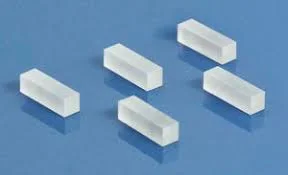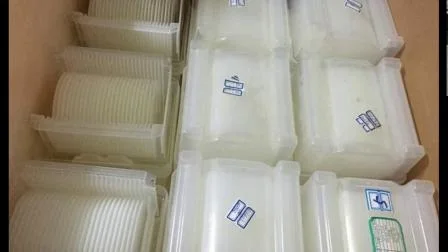
Ktp Nonlinear Crystal Potassium Titanyl Phosphate
Descriptions: KTP Nonlinear crystal Potassium Titanyl Phosphate is the most commonly used material for frequency doublin
Send your inquiryDESCRIPTION
Basic Info
| After-sales Service | Respond Within 24 Hours After Receiving Feedback. |
| Warranty | 1 Year |
| Customized | Customized |
| Standard Component | Standard Component |
| Type | Laser Source |
| Transport Package | as Request |
| Specification | customized |
| Trademark | optu |
| Origin | Chengdu |
| HS Code | 9001909090 |
| Production Capacity | 5000 Pieces / Year |
Product Description
Descriptions:KTP Nonlinear crystal Potassium Titanyl Phosphate is the most commonly used material for frequency doubling of Nd-doped lasers, particularly at the low or medium power density. It is widely used for frequency mixing to generate Red/Green/Blue output, and for OPO and OPA to generate visible to mid-infrared tunable output. It is also used for many E-O devices such as Q-switches and E-O modulators.
Main applications:
1) Frequency Doubling (SHG) of Nd-doped Lasers for Green/Red Output;
2) Frequency Mixing (SFM) of Nd Laser and Diode Laser for Blue Output;
3) Parametric Sources (OPG, OPA and OPO) for 600nm - 4500nm Tunable Ouptut;
4) E-O Modulators, Optical Switches, Directional Couplers;
5) Optical Waveguides for Integrated NLO and E-O DevicesOPA and OPO.
Advantages:
1) Large nonlinear optical coefficient;
2) Wide angular bandwidth and small walk-off angle
3) Broad temperature and spectral bandwidth;
4) High Electro-Optics(E-O) coefficient and low dielectric constant;
5) Non-hygroscopic, chemically and mechanically stable
Optical and Nonlinear properties of KTP crystal
| Transparency Range | 350~4500nm |
| SHG Phase Matchable Range | 497 ~ 1800nm (Type II) |
| Therm-optic Coefficient (/ºC, λ in μm) | dnx/dT=1.1X10-5dny/dT=1.3X10-5dnz/dT=1.6X10-5 |
| Absorption Coefficients | <0.1%/cm at 1064nm <1%/cm at 532nm |
| Angle Acceptance | 14.2mrad·cm (φ);55.3mrad·cm (θ) for Type II SHG of a Nd:YAG laser at 1064nm |
| Temperature Acceptance | 24°C·cm for Type II SHG of a Nd:YAG laser at 1064nm |
| Spectral Acceptance | 0.56nm·cm for Type II SHG of a Nd:YAG laser at 1064nm |
| Walk-off Angle | 0.55° for Type II SHG of a Nd:YAG laser at 1064nm |
| NLO Coefficients | deff(II)≈(d24 - d15)sin2Φsin2θ - (d15sin2Φ + d24cos2Φ)sinθ |
| Non-vanished NLO susceptibilities | d31=6.5 pm/V d24=7.6 pm/Vd32= 5 pm/V d15=6.1 pm/Vd33=13.7 pm/V |
| Sellmeier Equations (λ in μm) | nx2=3.0065+0.03901/(λ2-0.04251)-0.01327λ2ny2=3.0333+0.04154/(λ2-0.04547)-0.01408λ2nz2=3.3134+0.05694/(λ2-0.05658)-0.01682λ2 |
| Electro-optic Coefficients:r13r23r33r51r42 | Low and High frequency (pm/V)9.5 and 8.815.7and 13.836.3 and 357.3 and 6.99.3 and 8.8 |
| Relative Dielectric Constant | εeff=13 |
Physical properties of KTP crystal
| Crystal Structure | Orthorhombic, space group Pna21,point group mm2 |
| Lattice Parameter | a=6.404Å, b=10.616Å, c=12.814A, Z=8 |
| Melting Point | About 1172°C |
| Mohs Hardness | 5 |
| Density | 3.01 g/cm3 |
| Refractive indices | nX = 1,7404; nY = 1,7479; nZ = 1,8296 @1064 nm |
| Thermal Conductivity | 13W/m/K |
| Thermal Expansion Coefficients | ax=11x10-6/ºC, ay=9x10-6/ºC, az=0.6x10-6/ºC |
OPTU offers KTP specifications:
| Tolerance of cutting angle | △θ≤±0.25°,△φ≤±0.25° |
| Tolerance of dimension | Dimension+0/-0.1 mm,L:±0.1mm |
| Flatness | λ/10 @ 632.8nm |
| Wavefront distortion | λ/[email protected] 632.8nm |
| Surface quality | 10/5 per MIL-O-13830A |
| Parallelism | 20″ |
| Perpendicularity | 5′ |
| Clear Aperture: | > 90% |
| Chamfer: | < 0.1 mm @ 45° |
| Size | Upon customer request |
| Coating | AR/HR coating upon customer's request |
| Damage Threshold | 750MW/CM2 at 1064nm, TEM00, 10ns, 10Hz |
| Quality Warranty Period | One year under proper use |

Related Products
-
![Electro-Optical Devices, Multiplier and Acousto-Optic Devices-Litao3 Crystal]()
Electro-Optical Devices, Multiplier and Acousto-Optic Devices-Litao3 Crystal
-
![High Quality Medical Injection Glass Vial, Standard Scintillation Glass Vial]()
High Quality Medical Injection Glass Vial, Standard Scintillation Glass Vial
-
![Disposable Carbonization 100% Bamboo Straw Biodegradable Hot Sale Eco-Friendly Product 7.0*200 mm]()
Disposable Carbonization 100% Bamboo Straw Biodegradable Hot Sale Eco-Friendly Product 7.0*200 mm
-
![Srtio3 Sto Strontium Titanate Crystal Substrates Sto Substrate]()
Srtio3 Sto Strontium Titanate Crystal Substrates Sto Substrate











